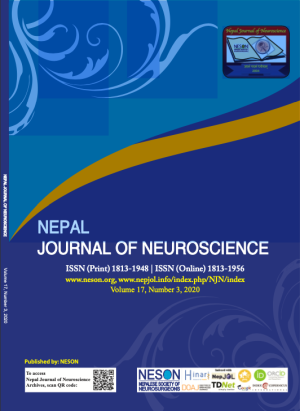Analysis of Clinicoradiological Profile and Outcome of Traumatic Basal Ganglia Hematoma: A Perspective from Level 1 Trauma Center
DOI:
https://doi.org/10.3126/njn.v17i3.33122Keywords:
Prognosis, Traumatic basal ganglia hematomaAbstract
Introduction: This study was conducted to analyze clinico-radiological profile of traumatic basal ganglia hematoma and identify its prognostic factors.
Methods and Materials: A prospective study was conducted in the Department of neurosurgery, Trauma center of Banaras Hindu University from September 2016 to March 2020. All patients with traumatic basal ganglia hematoma based on admission CT scan were enrolled and their demographic, clinical, radiological details were maintained till the time of discharge and subsequent follow up. Follow up period was a maximum of two years.
Results: Out of 41 patients of traumatic basal ganglia hematoma, 68% of cases were males in their third decade. Road traffic accident (76%) was the major etiology. 32% had severe head injury, 78% had hemiparesis at admission and 58% patients required ventilatory support. The mean volume of clot was 15.46 millilitres. Only 24% cases had isolated traumatic basal ganglia hematoma. Advance age, associated intraventricular hemorrhage, ventilator dependence, large hematoma (volume >20 millilitres) and poor Glasgow coma score at admission were significant prognostic factors (p<0.05).
Conclusion: Traumatic basal ganglia hematoma is a rare entity. Advance age, large volume of hematoma, associated intraventricular hemorrhage, poor Glasgow coma score at admission and ventilator dependence are poor prognostic factors.




